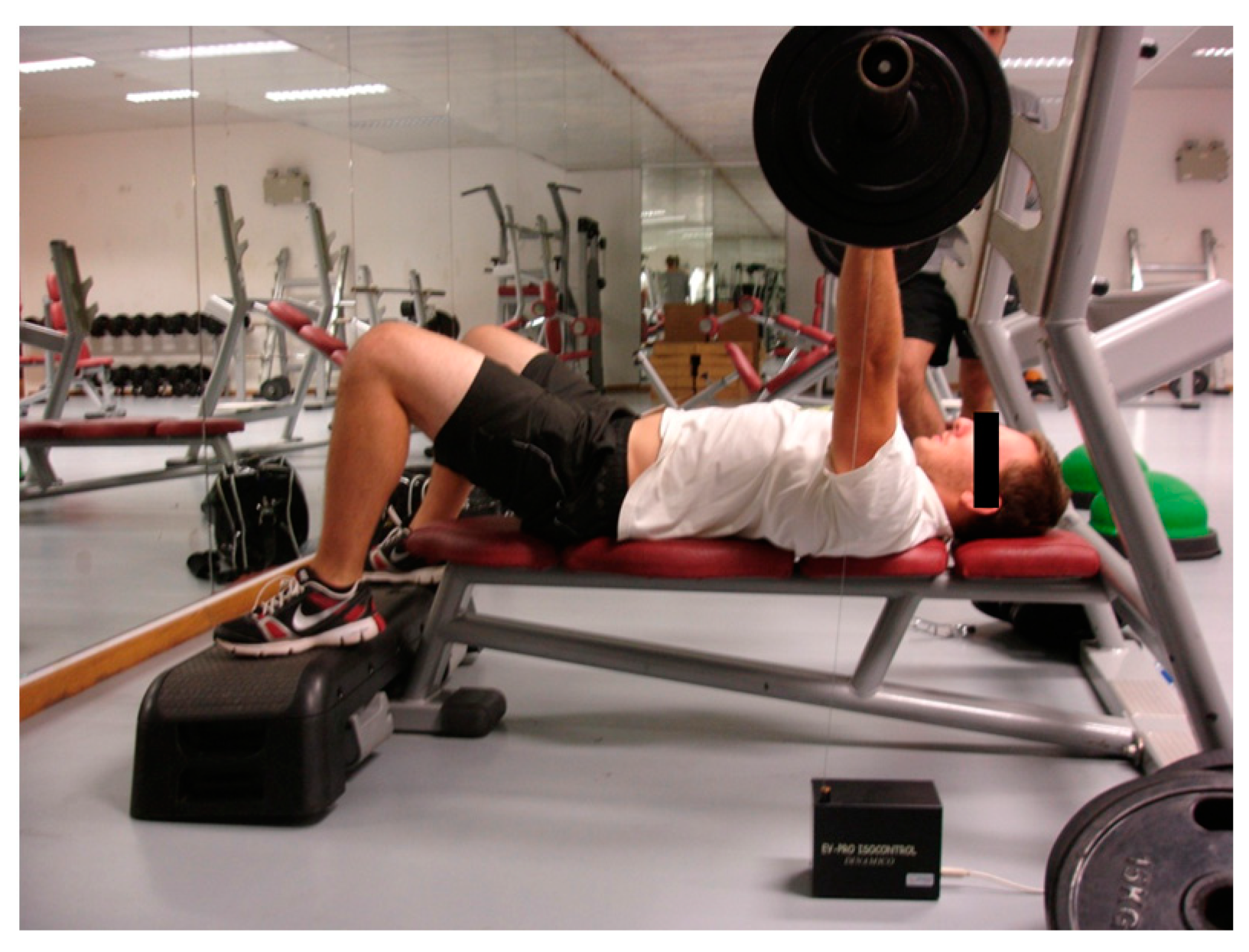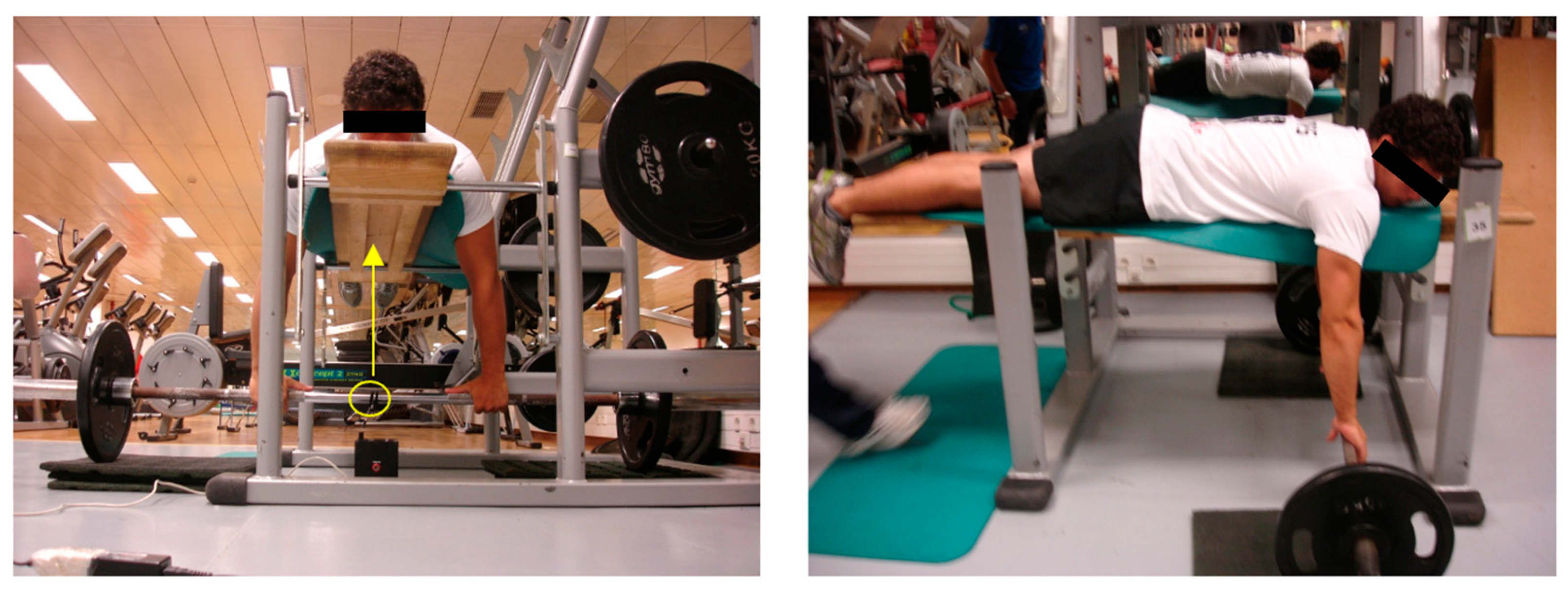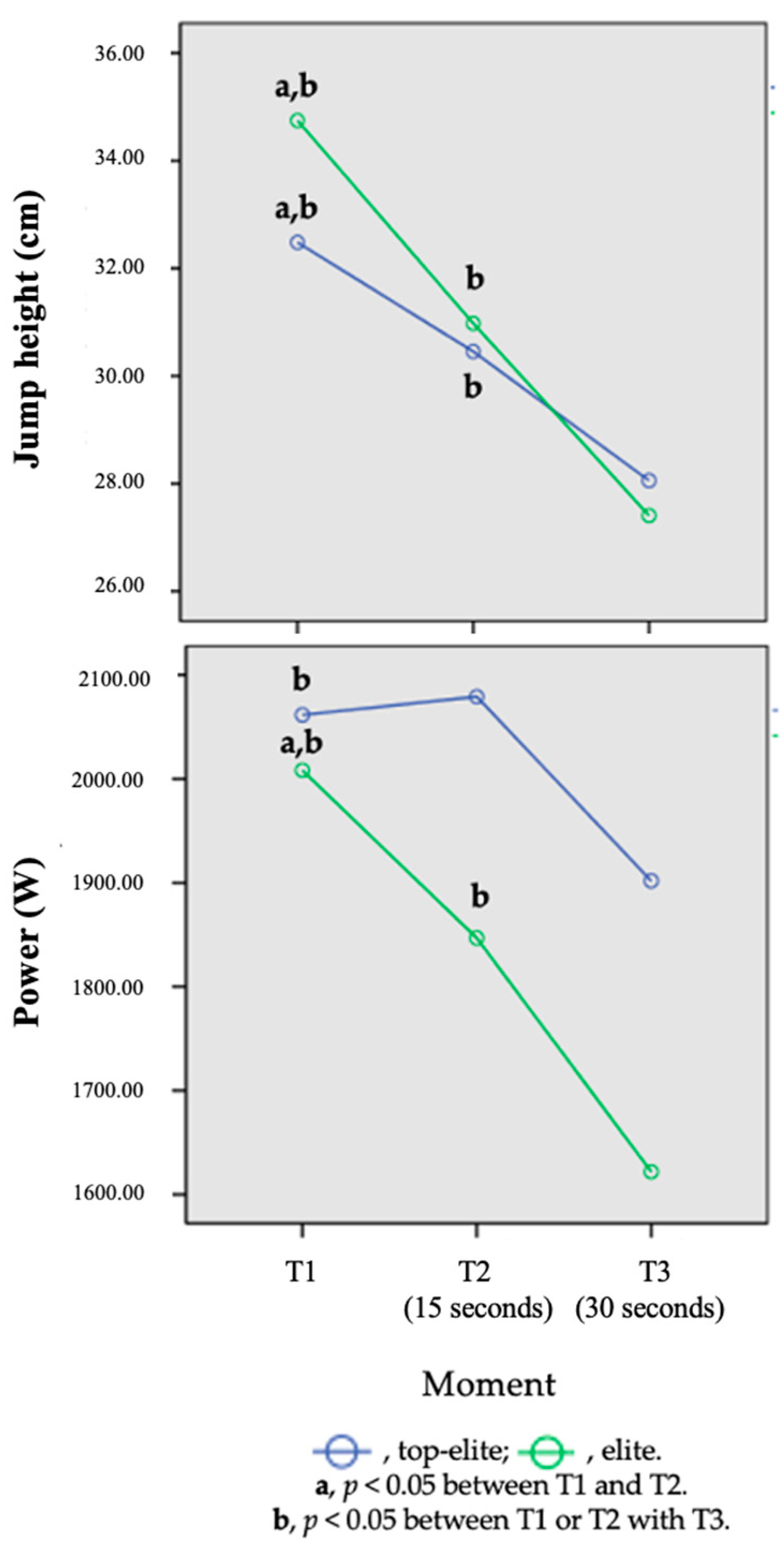Neuromuscular Performance of World-Class Judo Athletes on Bench Press, Prone Row and Repeated Jump Tests
Abstract
1. Introduction
2. Methods
2.1. Participants
2.2. Neuromuscular Evaluations
2.3. Statistical Analysis
3. Results
4. Discussion
5. Conclusions
Author Contributions
Funding
Institutional Review Board Statement
Informed Consent Statement
Data Availability Statement
Acknowledgments
Conflicts of Interest
References
- Serrano-Huete, V.; Latorre-Román, P.; García-Pinillos, F.; Morcillo Losa, J.; Moreno-Del Castillo, R.; Párraga-Montilla, J. Acute effect of a judo contest on muscular performance parameters and physiological response. Int. J. Kinesiol. Sports Sci. 2016, 4, 24–31. [Google Scholar] [CrossRef]
- Ren, M.; Tian, Y.; McNeill, C.; Lenetsky, S.; Uthoff, A. The Role and Development of Strength for Elite Judo Athletes. Strength Cond. J. 2023, 45, 663–673. [Google Scholar] [CrossRef]
- Franchini, E.; Del Vecchio, F.B.; Matsushigue, K.A.; Artioli, G.G. Physiological Profiles of Elite Judo Athletes. Sports Med. 2011, 41, 147–166. [Google Scholar] [CrossRef]
- Kons, R.; Franchini, E.; Detanico, D. Neuromuscular and judo-specific tests: Can they predict judo athletes’ ranking performance? Kinesiol. Coach. 2020, 20, 15–23. [Google Scholar]
- Franchini, E.; Artioli, G.G.; Brito, C.J. Judo combat: Time-motion analysis and physiology. Int. J. Perform. Anal. Sport 2013, 13, 624–641. [Google Scholar] [CrossRef]
- Marcos, S.U.; Rodríguez-Rodríguez, R.; Alfaro-Saiz, J.-J.; Carballeira, E.; Marcos, M.U. Improving on Half-Lightweight Male Judokas’ High Performance by the Application of the Analytic Network Process. Front. Psychol. 2021, 12, 621454. [Google Scholar] [CrossRef] [PubMed]
- Bonitch-Domínguez, J.; Bonitch-Góngora, J.; Padial, P.; Feriche, B. Changes in peak leg power induced by successive judo bouts and their relationship to lactate production. J. Sports Sci. 2010, 28, 1527–1534. [Google Scholar] [CrossRef]
- Komi, P.V.; Nicol, C. Stretch-Shortening Cycle Fatigue. In Biomechanics and Biology of Movement; McIntosh, B., Nigg, B., Eds.; Human Kinetics Publication: Champaign, IL, USA, 2000. [Google Scholar]
- Kostrzewa, M.; Laskowski, R.; Wilk, M.; Błach, W.; Ignatjeva, A.; Nitychoruk, M. Significant Predictors of Sports Performance in Elite Men Judo Athletes Based on Multidimensional Regression Models. Int. J. Environ. Res. Public Health 2020, 17, 8192. [Google Scholar] [CrossRef]
- Ceylan, B.; Šimenko, J.; Balcı, S.S. Which Performance Tests Best Define the Special Judo Fitness Test Classification in Elite Judo Athletes? J. Funct. Morphol. Kinesiol. 2022, 7, 101. [Google Scholar] [CrossRef]
- Narazaki, N.; Narazaki, K.; Atergiou, N. Kinetic and Kinematic analysis of a judo throwing technique: Osoto-gari. Bull. Assoc. Sci. Stud. Judo 2007, 11, 19–31. [Google Scholar]
- Monteiro, L.F.; Massuça, L.M.; García, J.G.; Carratala, V.; Proença, J. Plyometric muscular action tests in judo- and non-judo athletes. Isokinet. Exerc. Sci. 2011, 1, 287–293. [Google Scholar] [CrossRef]
- Gollhofer, A.; Komi, P.V.; Miyashita, M.; Aura, O. Fatigue During Stretch-Shortening Cycle Exercises: Changes in Mechanical Performance of Human Skeletal Muscle. Int. J. Sports Med. 1987, 8, 71–78. [Google Scholar] [CrossRef]
- Fagerlund, R.; Hakkinen, H. Strength profile of Finnish judoist, measurement and evaluation. Biol. Sport 1991, 8, 143–149. [Google Scholar]
- Thomas, S.G.; Cox, M.H.; LeGal, Y.M.; Verde, T.J.; Smith, H.K. Physiological profiles of the Canadian National Judo Team. Can. J. Sport Sci. 1989, 13, 142–147. [Google Scholar]
- Claessens, A.M.; Beunen, G.; Lefevre, J. Body Structure, Somatotype, and Motor Fitness of Top-Class Belgian Judoists. In Perspectives in Kinanthropometry; Day, J.A.P., Ed.; Human Kinetics: Champaign, IL, USA, 1984; pp. 155–163. [Google Scholar]
- Brown, L.; Weir, S. ASEP Procedures Recommendation I: Accurate Assessment of Muscular Strength and Power. J. Exerc. Physiol. 2001, 4, 1–21. [Google Scholar]
- Lucic, J. Prognostic Validity of some Situation Motor Test for Judo. Fiz. Kult. 1989, 23, 147–152. [Google Scholar]
- Bosco, C.; Luhtanen, P.; Komi, P.V. A Simple Method for Measurement of Mechanical Power in Jumping. Eur. J. Appl. Physiol. Occup. Physiol. 1983, 50, 273–282. [Google Scholar] [CrossRef]
- Cormie, P.; McBride, J.M.; McCaulley, G.O. Power-Time, Force-Time, and Velocity-Time Curve Analysis of the Countermovement Jump: Impact of Training. J. Strength Cond. Res. 2009, 23, 177–186. [Google Scholar] [CrossRef]
- González-Badillo, J.J.; Marques, M.C. Relationship between Kinematic Factors and Countermovement Jump Height in Trained Track and Field Athletes. J. Strength Cond. Res. 2010, 24, 3443–3447. [Google Scholar] [CrossRef]
- Hopkins, W.G. Measures of Reliability in Sports Medicine and Science. Sports Med. 2000, 30, 1–15. [Google Scholar] [CrossRef]
- Callister, R.; Callister, R.J.; Staron, R.S.; Fleck, S.J.; Tesch, P.; Dudley, G.A. Physiological characteristics of elite judo athletes. Int. J. Sports Med. 1991, 2, 196–203. [Google Scholar] [CrossRef]
- Almeida, F.; Padial, P.; Bonitch-Góngora, J.; de la Fuente, B.; Schoenfeld, B.J.; Morales-Artacho, A.J.; Benavente, C.; Feriche, B. Effects of Power-Oriented Resistance Training During an Altitude Camp on Strength and Technical Performance of Elite Judokas. Front. Physiol. 2021, 12, 606191. [Google Scholar] [CrossRef]
- Sbriccoli, P.; Bazzucchi, I.; DI Mario, A.; Marzattinocci, G.; Felici, F. Assessment of maximal cardiorespiratory performance and muscle power in the Italian Olympic judoka. J. Strength Cond. Res. 2007, 21, 738–744. [Google Scholar] [CrossRef]
- Franchini, E.; Nunes, A.V.; Moraes, J.M.; Del Vecchio, F.B. Physical Fitness and Anthropometrical Profile of the Brazilian Male Judo Team. J. Physiol. Anthr. 2007, 26, 59–67. [Google Scholar] [CrossRef]
- Moss, B.M.; Refsnes, P.E.; Abildgaard, A.; Nicolaysen, K.; Jensen, J. Effects of maximal effort strength training with different loads on dynamic strength, cross-sectional area, load-power and load-velocity relationships. Eur. J. Appl. Physiol. 1997, 75, 193–199. [Google Scholar] [CrossRef]
- Chaouachi, A.; Coutts, A.J.; Chamari, K.; Wong, D.P.; Chaouachi, M.; Chtara, M.; Roky, R.; Amri, M. Effect of Ramadan Intermittent Fasting on Aerobic and Anaerobic Performance and Perception of Fatigue in Male Elite Judo Athletes. J. Strength Cond. Res. 2009, 23, 2702–2709. [Google Scholar] [CrossRef]
- Komi, P.V. Stretch-Shortening Cycle. In Strength and Power in Sport; Komi, P.V., Ed.; Blackwell Science: Oxford, UK, 2003; pp. 184–202. [Google Scholar]
- Dietz, V.; North, J.; Berger, W. Interaction between pre-activity and stretch reflex in human triceps brachii during landing from forwards falls. J. Physiol. 1981, 311, 113–125. [Google Scholar] [CrossRef]
- Cormie, P.; McGuigan, M.; Newton, R. Developing Maximal Neuromuscular Power: Part 1—Biological Basis of Maximal Power Production. Sports Med. 2011, 41, 17–38. [Google Scholar] [CrossRef]
- Cormie, P.; McGuigan, M.; Newton, R. Developing Maximal Neuromuscular Power: Part 2—Training Considerations for Improving Maximal Power Production. Sports Med. 2011, 41, 125–146. [Google Scholar] [CrossRef]



| Dependent Variables | Bench Press | Prone Row | ||||
|---|---|---|---|---|---|---|
| Top-Elite | Elite | p-Value | Top-Elite | Elite | p-Value | |
| Peak velocity (m/s) A | 5.48 ± 0.67 | 5.08 ± 0.54 | <0.01 | 2.94 ± 1.00 | 2.76 ± 0.75 | 0.420 |
| Maximum load 1RM (kg) | 114.03 ± 19.45 | 82.42 ± 19.65 | <0.001 | 105.27 ± 17.95 | 93.33 ± 14.67 | 0.005 |
| Power load (kg) | 57.57 ± 10.81 | 41.15 ± 12.16 | <0.001 | 58.57 ± 10.43 | 48.24 ± 10.35 | <0.001 |
| Power load (% of 1RM) | 50.72 ± 6.70 | 49.87 ± 7.35 | 0.634 | 56.02 ± 7.40 | 51.70 ± 7.23 | 0.023 |
| Peak power (W) | 1107.16 ± 323.76 | 757.56 ± 207.47 | <0.001 | 1191.18 ± 318.63 | 986.60 ± 291.29 | 0.010 |
| Relative peak power (W/kg) | 14.14 ± 4.01 | 10.76 ± 2.89 | <0.001 | 15.17 ± 3.63 | 13.48 ± 3.64 | 0.070 |
| Power mean (W) | 709.10 ± 151.39 | 504.68 ± 122.90 | <0.001 | 804.28 ± 174.15 | 681.09 ± 186.38 | 0.009 |
| Relative power mean (W/kg) | 9.05 ± 1.76 | 7.13 ± 1.60 | <0.001 | 10.29 ± 1.94 | 9.25 ± 1.96 | 0.040 |
| Peak force (N) | 2062.47 ± 597.40 | 1290.31 ± 373.88 | <0.001 | 1677.48 ± 496.07 | 1556.95 ± 384.79 | 0.283 |
| Relative peak force (N/kg) | 26.11 ± 5.96 | 18.28 ± 4.91 | <0.001 | 21.55 ± 6.54 | 21.19 ± 4.21 | 0.797 |
| Force mean to peak power (N) | 932.42 ± 289.98 | 607.86 ± 161.92 | <0.001 | 805.66 ± 162.89 | 716.34 ± 154.65 | 0.029 |
| Relative force mean to peak power (N/kg) | 11.97 ± 3.73 | 8.64 ± 2.23 | <0.001 | 10.32 ± 1.87 | 9.78 ± 1.70 | 0.238 |
| Force mean (N) | 1146.54 ± 248.02 | 866.72 ± 224.19 | <0.001 | 1149.66 ± 238.64 | 1015.96 ± 167.18 | 0.012 |
| Rate of force development (N/s) | 103224.20 ± 16379.57 | 65605.15 ± 22515.31 | <0.001 | 94887.10 ± 26779.61 | 67327.05 ± 20171.80 | <0.001 |
| Relative rate of force development (N/s/kg) | 1335.08 ± 273.93 | 944.08 ± 355.64 | <0.001 | 1219.68 ± 360.31 | 918.90 ± 264.97 | <0.001 |
| Time to peak force (ms) | 22.60 ± 5.67 | 25.30 ± 10.93 | 0.230 | 24.00 ± 9.14 | 28.58 ± 12.43 | 0.099 |
| Time to peak power (ms) | 311.70 ± 48.62 | 305.33 ± 66.71 | 0.669 | 211.97 ± 52.71 | 199.06 ± 66.39 | 0.399 |
| Time between peaks (power and force) (ms) | 289.10 ± 48.97 | 280.03 ± 67.09 | 0.546 | 187.97 ± 50.75 | 170.48 ± 71.24 | 0.271 |
| Dependent Variables | Periods | Top-Elite | Elite | p-Value |
|---|---|---|---|---|
| Number of jumps (n) | All | 29.93 ± 3.90 | 29.36 ± 2.85 | 0.508 |
| Jump height (cm) | T1 | 32.48 ± 4.66 | 34.75 ± 6.22 | 0.110 |
| T2 | 30.46 ± 4.74 | 30.98 ± 5.91 | 0.702 | |
| T3 | 28.06 ± 5.38 | 27.41 ± 5.09 | 0.625 | |
| Contact time (ms) | T1 | 533.37 ± 97.42 | 593.55 ± 118.99 | 0.033 |
| T2 | 533.77 ± 106.42 | 578.91 ± 117.99 | 0.117 | |
| T3 | 545.70 ± 140.07 | 598.97 ± 113.45 | 0.101 | |
| Power (W) | T1 | 2061.55 ± 477.93 | 2008.21 ± 415.99 | 0.638 |
| T2 | 2079.09 ± 482.78 | 1846.77 ± 402.74 | 0.042 | |
| T3 | 1901.85 ± 431.45 | 1621.92 ± 344.68 | 0.006 | |
| Force (N) | T1 | 1795.82 ± 654.22 | 1871.98 ± 501.05 | 0.604 |
| T2 | 1905.17 ± 688.43 | 1722.68 ± 422.01 | 0.216 | |
| T3 | 1570.86 ± 476.38 | 1488.96 ± 391.35 | 0.457 | |
| Velocity (m/s) | T1 | 2.73 ± 0.33 | 2.85 ± 0.36 | 0.175 |
| T2 | 2.73 ± 0.30 | 2.73 ± 0.36 | 0.995 | |
| T3 | 2.66 ± 0.43 | 2.63 ± 0.42 | 0.758 |
Disclaimer/Publisher’s Note: The statements, opinions and data contained in all publications are solely those of the individual author(s) and contributor(s) and not of MDPI and/or the editor(s). MDPI and/or the editor(s) disclaim responsibility for any injury to people or property resulting from any ideas, methods, instructions or products referred to in the content. |
© 2024 by the authors. Licensee MDPI, Basel, Switzerland. This article is an open access article distributed under the terms and conditions of the Creative Commons Attribution (CC BY) license (https://creativecommons.org/licenses/by/4.0/).
Share and Cite
Monteiro, L.; Massuça, L.M.; Ramos, S.; Garcia-Garcia, J. Neuromuscular Performance of World-Class Judo Athletes on Bench Press, Prone Row and Repeated Jump Tests. Appl. Sci. 2024, 14, 2904. https://doi.org/10.3390/app14072904
Monteiro L, Massuça LM, Ramos S, Garcia-Garcia J. Neuromuscular Performance of World-Class Judo Athletes on Bench Press, Prone Row and Repeated Jump Tests. Applied Sciences. 2024; 14(7):2904. https://doi.org/10.3390/app14072904
Chicago/Turabian StyleMonteiro, Luís, Luís Miguel Massuça, Sérgio Ramos, and José Garcia-Garcia. 2024. "Neuromuscular Performance of World-Class Judo Athletes on Bench Press, Prone Row and Repeated Jump Tests" Applied Sciences 14, no. 7: 2904. https://doi.org/10.3390/app14072904
APA StyleMonteiro, L., Massuça, L. M., Ramos, S., & Garcia-Garcia, J. (2024). Neuromuscular Performance of World-Class Judo Athletes on Bench Press, Prone Row and Repeated Jump Tests. Applied Sciences, 14(7), 2904. https://doi.org/10.3390/app14072904








